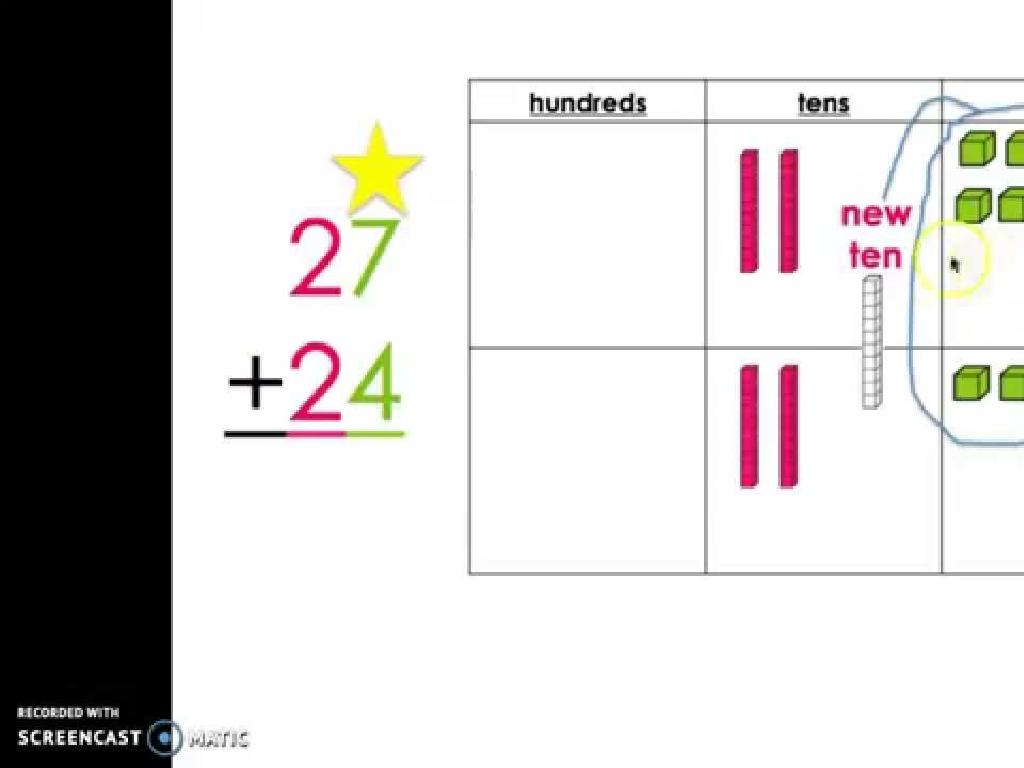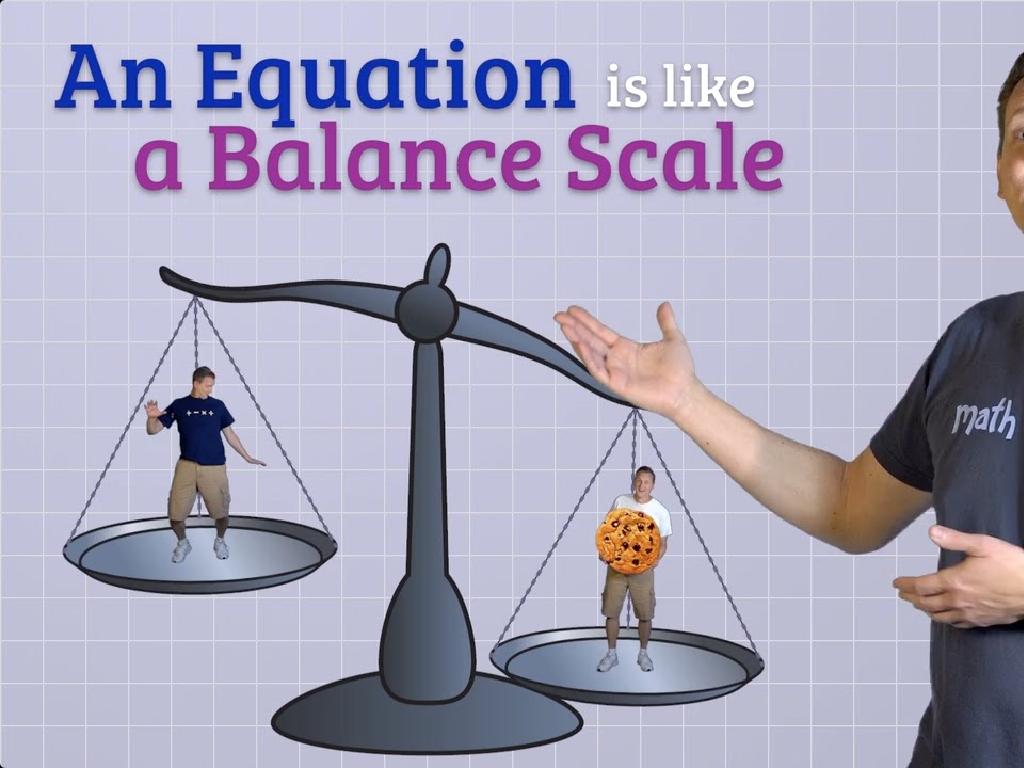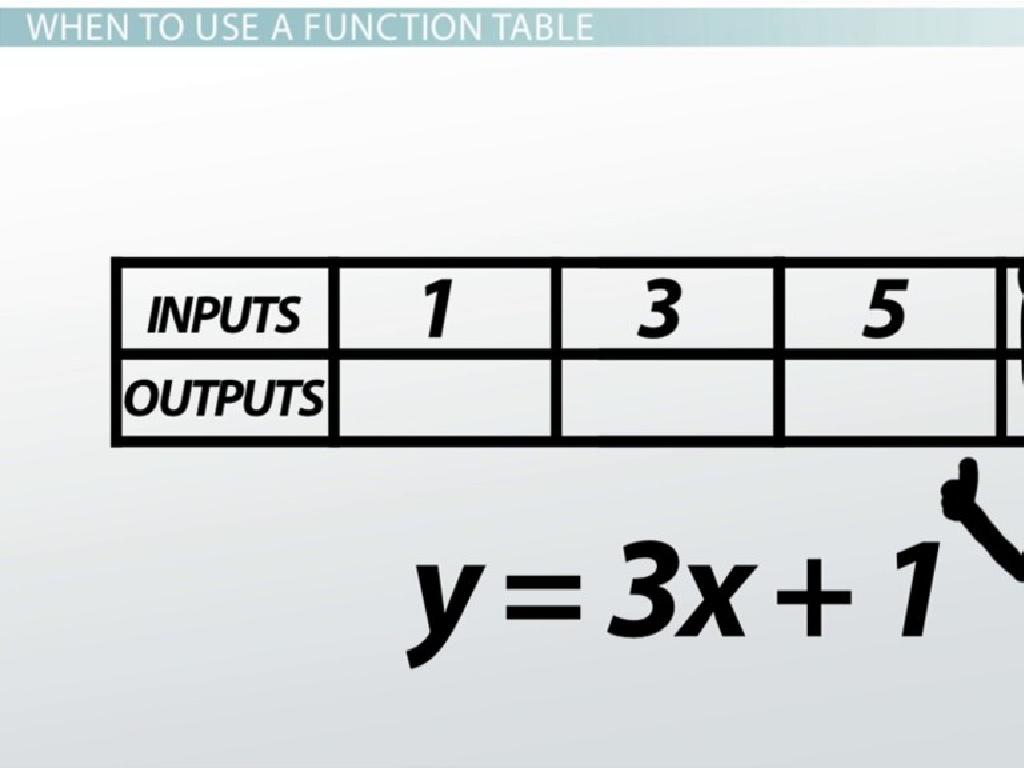Balanced And Unbalanced Forces
Subject: Science
Grade: Seventh grade
Topic: Velocity, Acceleration, And Forces
Please LOG IN to download the presentation. Access is available to registered users only.
View More Content
Understanding Balanced and Unbalanced Forces
– Forces: Pushes and Pulls
– Force is a push or pull that can change an object’s motion.
– Forces and Motion
– Motion of an object changes when force is applied.
– Balanced Forces Explained
– Equal forces acting in opposite directions that do not change motion.
– Unbalanced Forces in Action
– When forces are unequal, they cause a change in the object’s motion.
|
This slide introduces the concept of forces as pushes or pulls that can cause an object to move, stop, or change direction. Emphasize that forces are vectors with both magnitude and direction. Balanced forces are equal in size but opposite in direction, resulting in no change in motion, while unbalanced forces are not equal and cause a change in motion. Provide examples such as tug-of-war for balanced forces and a person pushing a shopping cart for unbalanced forces. Encourage students to think of more examples from their daily life and be prepared to discuss how these forces affect the motion of objects.
Understanding Forces
– Definition of force
Force is a push or pull upon an object resulting from its interaction with another object.
– Force measured in Newtons
The unit of force is the Newton (N), named after Sir Isaac Newton.
– Everyday examples of forces
Examples include kicking a ball, magnets pulling, and gravity holding us on Earth.
– Impact of forces on motion
|
Begin the lesson by defining force as a push or pull that can cause an object to accelerate, stop, or change direction. Explain that the standard unit of force is the Newton (N), which quantifies the amount of force applied. Provide relatable examples such as kicking a ball (applied force), the force of magnets (magnetic force), and the force of gravity (gravitational force). Emphasize how these forces are present in students’ daily lives and how they can cause objects to start moving, stop, or change their velocity. This will set the foundation for understanding how forces are balanced or unbalanced, leading to either a state of rest or motion.
Exploring Balanced Forces
– Define Balanced Forces
– Forces that are equal in size but opposite in direction, canceling each other out.
– Characteristics of Balanced Forces
– No change in motion; objects at rest stay at rest, objects in motion stay in motion.
– Real-life Balanced Force Examples
– Tug-of-war at a standstill, a book resting on a table without moving.
– Equilibrium and Motion
– When balanced forces act on an object, it is in equilibrium; there is no acceleration.
|
This slide introduces the concept of balanced forces, which are essential to understanding how objects interact within their environment. Balanced forces occur when two forces acting in opposite directions on an object are equal in size, resulting in no net force and no change in the object’s motion. This state is known as equilibrium. It’s important for students to recognize that even when an object appears to be still, there may be forces acting upon it. Use everyday examples like a game of tug-of-war or a stationary object to illustrate this concept. Encourage students to think of other examples where forces balance each other out and to consider the implications of balanced forces in both static and dynamic situations.
Exploring Unbalanced Forces
– Define unbalanced forces
– Forces not equal in size, opposite in direction
– Unbalanced forces change motion
– Causes acceleration or deceleration
– Real-life examples
– Pushing a shopping cart, kicking a ball
– Analyzing force impact
– Observe how objects move or stop
|
Unbalanced forces occur when two forces acting on an object are not equal in size or are not opposite in direction, resulting in a change of motion. This change can be an acceleration (speeding up) or a deceleration (slowing down). Provide students with relatable examples such as pushing a shopping cart (which moves due to an unbalanced force) or kicking a ball (where the force of the kick overcomes the force of friction). Encourage students to think of other examples from their daily lives and to observe the effects of unbalanced forces around them. This will help them understand the concept of net force and its role in motion.
Comparing Balanced and Unbalanced Forces
– Balanced vs. Unbalanced Forces
– Balanced forces do not change an object’s motion, while unbalanced forces do.
– Determining Force Balance
– Compare the size and direction of forces acting on an object.
– Understanding Net Force
– Net force is the overall force acting on an object after all forces are combined.
– Effects on Object Motion
– Unbalanced forces cause acceleration, while balanced forces result in constant motion or rest.
|
This slide aims to help students understand the difference between balanced and unbalanced forces and their effects on an object’s motion. Balanced forces are equal in size and opposite in direction, canceling each other out, so there is no change in motion. Unbalanced forces are not equal and/or not opposite, resulting in a net force that changes an object’s motion, causing acceleration. To determine if forces are balanced or unbalanced, students should look at the magnitude and direction of all forces acting upon an object and calculate the net force. Examples to illustrate these concepts can include tug-of-war (balanced forces) and a pushed shopping cart (unbalanced forces).
Forces in Action: Classroom Experiments
– Live demo: Tug of War
– Observe the balance or imbalance of forces in a tug of war
– Analyze motion: Toy Car
– Use a toy car to see how forces affect motion
– Discuss the observed forces
– Why does the car move or stop? What forces are at play?
– Understand balanced forces
– When forces are equal and opposite, no change in motion occurs
|
This slide introduces hands-on activities to help students understand the concepts of balanced and unbalanced forces. The tug of war demonstration allows students to physically feel the forces at play, while the toy car experiment provides a visual representation of how forces affect motion. Encourage students to observe and discuss what happens when forces are balanced versus when they are unbalanced. The discussion should lead to the conclusion that balanced forces result in no change in motion, while unbalanced forces cause acceleration. Provide guidance on setting up the experiments and ensure safety measures are followed. Possible variations of the tug of war could involve different numbers of participants or using a spring scale to measure force.
Forces and Motion: Velocity & Acceleration
– Forces impact velocity & acceleration
– A push or pull can speed up, slow down, or change an object’s direction.
– Graphs show motion over time
– Distance-time graphs can illustrate an object’s speed and how it changes.
– Linking forces to motion changes
– Forces cause objects to start moving, stop moving, or change direction.
– Balanced vs. unbalanced forces
– Balanced forces keep motion steady; unbalanced forces change it.
|
This slide introduces the relationship between forces, velocity, and acceleration. Begin by explaining how forces can affect an object’s speed and direction, leading to changes in velocity and acceleration. Use graphical representations, such as distance-time graphs, to visually demonstrate how an object’s motion can be analyzed over time. Discuss how balanced forces result in constant velocity, while unbalanced forces lead to acceleration. Provide examples such as a car speeding up or slowing down to illustrate these concepts. Encourage students to think of everyday situations where they can observe these principles in action.
Class Activity: Investigating Forces
– Overview of force investigation
– List of required materials
– Objects of various weights, a spring scale, a smooth surface.
– Follow the experiment steps
– Attach object to scale, pull gently, note the force required to move it.
– Observe and record results
– Compare results with different objects to understand balanced/unbalanced forces.
|
This activity is designed to give students hands-on experience with understanding the concept of balanced and unbalanced forces. Provide a variety of objects with different weights so students can observe how the amount of force needed to move an object changes. The spring scale will help them quantify the force applied. Ensure that students understand how to use the scale correctly and record their observations meticulously. After the activity, discuss how the results demonstrate the principles of balanced and unbalanced forces. Encourage students to explain their findings in the context of Newton’s laws of motion. Possible variations of the activity could include changing the surface to compare how friction affects the force needed or using a digital force meter for more accurate measurements.
Conclusion: Forces in Our Daily Lives
– Recap: Balanced vs. Unbalanced Forces
– Balanced forces don’t change motion, unbalanced forces do.
– Forces’ role in everyday life
– Understanding forces helps explain walking, driving, and more.
– Apply knowledge to real-world scenarios
– Consider how seatbelts work or why we lean when turning.
– Open floor for Q&A session
|
As we wrap up, let’s review the key concepts of balanced and unbalanced forces. Balanced forces occur when equal forces are acting on an object in opposite directions, resulting in no change in motion. Unbalanced forces, on the other hand, result in a change of motion and are responsible for most of the movement we see. Understanding these forces allows us to analyze and predict the behavior of objects in our daily lives, such as why we don’t fall off our bikes when we’re moving or how cars accelerate. Encourage students to think of other examples where these principles apply. Finally, open the floor for a Q&A session to address any remaining uncertainties and solidify the students’ understanding.
Homework: Exploring Forces Around Us
– Identify forces in your surroundings
– Reflect on today’s force experiments
– Consider what you learned and felt during the experiments
– Study friction and gravity for next class
– What roles do friction and gravity play in motion?
– Document your observations
– Write down examples of balanced and unbalanced forces you see
|
This homework assignment is designed to reinforce the concepts of balanced and unbalanced forces by encouraging students to observe and reflect on these forces in their everyday environment. Students should identify examples of both types of forces and write a reflection on the experiments conducted in class, discussing their observations and insights. Additionally, they should begin to prepare for the next class by studying friction and gravity, two fundamental forces that affect motion. This will help them understand how these forces interact with each other and with the concepts they’ve learned about today. Encourage students to be curious and analytical about the world around them, and to document their findings in a structured manner.






